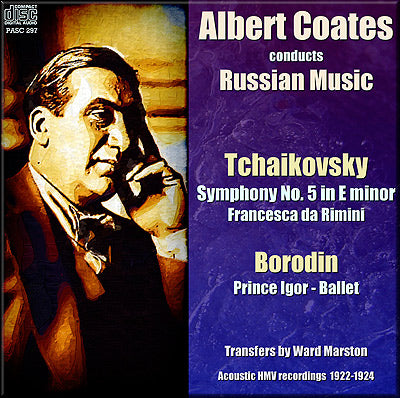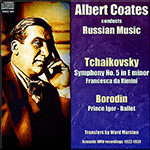
This album is included in the following sets:
This set contains the following albums:
- Historic Review
- Full Track Listing
- Cover Art
-
Review of Tchaikovsky Symphony No. 5, 1924:
"This symphony was completed in 1888 ; it stands apart from the others, as Mrs. Newmarch says, by reason of religious sentiment in the introductions to the first and second movements and yields to none of the composer's works for sheer brilliancy of orchestration; this probably accounts for it having recorded so well.
First Movement. Introduction, Aminnte.---Part I.—Clarinets with strings accompanying , out the leit-motiv or motto theme of the work ; this tune, of supposedly Polish folk song origin, is heard in all four movements of the symphony in some form or other ; it is intensely sombre and has about it the same atmosphere as Chopin's little C minor Prelude. The succeeding Allegro con anima is begun more slowly by the conductor than is usually the case, and its halting melancholy is thereby emphasised ; but it grows in animation when the clarinet and bassoon give way to the strings and the strings to the brass, and achieves the speed indicated in the heading as this side ends. Part II—There is a kind of musical bridge over to the second tune which contains some very piquant string pizzicati under held chords for wood and horns the alternating wood and string chords just before the entry of the second tune inevitably recall Beethoven. The second tune on wood and horns with a balancing phrase for strings is not developed, and yet another one appears, marked motto cantabile ed expressivo, on the strings ; a beautiful tune akin to similar lyrical tunes in the Sixth Symphony and the Pianoforte Concerto ; this is worked up to a climax formed by the re-entry of the second tune. The orchestra hints urgently at the first tune as this side ends. Part III. —Soon long notes on the horns bring us back to familiar ground, and the bassoon (with its usual comic suggestiveness) sings the first tune ; the other tunes make their due appearance and this side ends with the alternating wood and string chords heard in Part II. Part IV.--This begins with the emphatic second tune with its companion contabile, which is worked up into a climax of greater force than before, leading to a coda formed from the first tune, which follows an inverse process; for instead of increasing in animation to the close the music dies down through clarinets and strings to the low mutterings of a roll on the timpani. Thus the stage is set for the slow movement following.
Second Movement. Andante cantabile con alcuna licenza. Part I.—A solemn note is apparent in the opening string chords leading to the beautiful horn tune which lingers long in the memory; the oboe joins in a brief dialogue with the horn, this being the first appearance of the second tune, which later undergoes some development; clarinets, bassoons and strings in this order form a bridge back to the first tune now imbued with the rich colour of the 'cellos, with flute and oboe embroideries. Violins now come into prominence with a fuller version of the second tune rising to a climax typical of the composer—a climax formed by urging the tune ever higher ; the music is just reaching the third tune as this side ends. Part II.—This third tune is by way of relief to the highly charged music that has gone before and is heard on clarinet and bassoon, 'cello, and violins; suddenly the brass blare out the motto theme, and this is followed by a series of detached string chords which hold us in suspense. Then the violins with thrilling effect sing out the beautiful opening tune, developing a climax of great power as this side ends. Part III.- -It culminates in another dramatic entry of trumpet and trombone, and a final and very tender statement of the second tune on the strings (by way of coda); clarinets have the last word. The instrument tone is especially good all through this movement.
Third Movement. Valse. Allegro Moderato. Parts I and II.– -Here is welcome contrast—a light-hearted valse tune on the strings artfully contrived. Notice the Iong, spun phrase between the first two statements of the torte which is much more effective than immediate repetition. Oboe, bassoon, and clarinet (in its lower register) have some grateful music to play, and then clarinet and bassoon have the valse tune with string arpeggi. Later on comes a delicious pendant phrase for the bassoon, humorously flavoured. Rapid string and flute passages follow as the middle section of the movement, and for delicate handling are a great contrast to the previous movements. The valse tune steals in again on top of the quaver passages which die away as it obtains control of the music (compare Mendelssohn's Violin Concerto, slow movement, on repetition of the first tune). All proceeds as before until the code then, heard as an almost apologetic undertone, clarinet and bassoon sigh out the motto theme; but the music ends with defiant double fortes.
Fourth Movement. Andante maestoso. Part I. The motto theme now in the major key is invested with the full majesty of the strings; brass have some ponderous chords and then above string triplets and brass the motto theme on wood-wind becomes a triumphal march. The music changes from major to minor in a new tune and quickens (allegro vivace), but the note of rejoicing persists. Closely associated with it is a sprightly phrase for the oboe, of which much use is made. The music subsides to a heavy rhythmic tread as tins side ends. Parts II. and III.—A version of the first tune of the slow movement is now heard on wood-wind leading to a magnificent statement of the motto theme on trumpet and trombone, with brilliant upward rushes on strings and wood. From here onwards the tunes previously heard are worked out with most exciting orchestral devices, too detailed for analysis here. A big climax and a long roll on the timpani lead to the coda ; the apotheosis of the motto theme. This is projected against a background of swinging wood-wind triplets (moderato assai e molto maestoso)----it is indeed motto maestoso. Tchaikovsky literally hurls great splotches of vivid colour on his canvas until we are carried off our feet by the sheer exhilaration of it all. The final bars are a version of the allegro con anima tune of the first movement. Brahms disliked this movement, and it is easy to imagine its exuberance offended his reserved nature. Less sensitive persons will delight in it. The material may not be remarkable, but the way it is set out is masterly. Those who follow with scores should notice that invariably a few bars that have ended a side are repeated again at the beginning of the next side. This, from all points of view, seems to me the most successful symphony on the gramophone so far. (Miniature score, Goodwin and Tabb, 8s.)."
NEWMAN PASSAGE
The Gramophone, "Analytical Notes and First Reviews", June 1924
-
TCHAIKOVSKY - Symphony No. 5 in E minor, Op. 64
Recorded 25 October, 3 & 17 November, 22 December 1922
Issued on HMV D759-764
-
TCHAIKOVSKY - Francesca da Rimini - Symphonic Fantasy after Dante, Op 32
Recorded 22 & 24 October 1924
Issued on HMV D951-952
-
BORODIN - Prince Igor - Ballet [notes / score]
Recorded 18 October 1923
Issued on HMV D795
The Symphony Orchestra
Albert Coates, conductor
(Credited to The Symphony Orchestra, probably members of London Symphony Orchestra)
Transfers by Ward Marston
Cover artwork based on a photograph of Albert Coates
Total duration: 68:50

